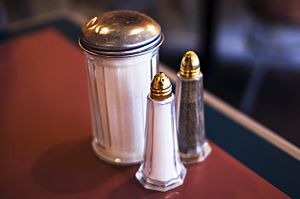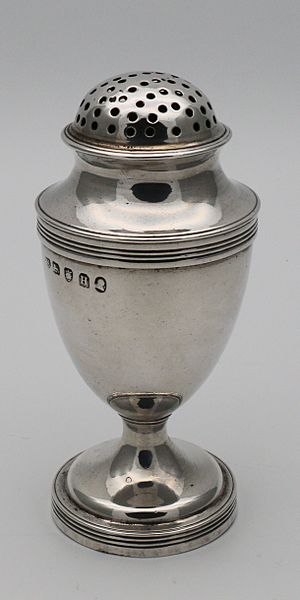Salt and pepper shakers facts for kids
Salt and pepper shakers are small containers that hold salt and pepper. People use them at the dinner table to add flavor to their food. They are also sometimes called salt and pepper pots. In British English, the salt container might be called a salt cellar. These handy tools help you sprinkle just the right amount of seasoning on your meal. Sometimes, shakers are kept together on a special holder called a cruet-stand.
Contents
What are Salt and Pepper Shakers Made Of?
Salt and pepper shakers can be made from many different materials. You might find them made of plastic, glass, metal, or ceramic.
How Did Salt Shakers Become Popular?
Salt shakers became much more common after the 1920s. This was when the Morton Salt company started adding special ingredients called anti-caking agents to salt. These agents stop the salt from clumping together, making it easier to shake out.
The Great Depression in the 1930s also helped make salt and pepper shakers very popular. During this time, companies that made ceramic items focused on creating things that were not expensive. This made shakers affordable for many families.
Cool Designs and Collecting Shakers
Most of the time, salt and pepper shakers come as a matching set. You can often tell them apart by looking at the number of holes on top. One might have more holes for pepper, and the other fewer for salt.
Unique and Fun Designs
Shakers come in all sorts of designs! Some are simple glass containers with screw caps. These were first invented by John Landis Mason, who also invented the Mason jar. Other shakers are like small works of art.
You might see sets designed to look like two related things. For example, one shaker could be a West Highland White Terrier dog holding salt, and the other a Scottish Terrier dog holding pepper. Some designs are even made for special holidays or events.
Collecting Salt and Pepper Shakers
Because there are so many different designs, collecting salt and pepper shakers is a fun hobby for many people. The way shakers are designed can also show us things about different cultures and their values.
There are even special places dedicated to these everyday items! You can visit Museums of Salt and Pepper Shakers in the United States and Spain. These museums show off the many different kinds of shakers from history. Żupny Castle in Poland also has a collection of salt shakers.
How to Tell Salt from Pepper Shakers
It can sometimes be tricky to tell which shaker holds salt and which holds pepper. The way they are designed can depend on where you are in the world.
Number of Holes
The number of holes on top of the shaker can be a clue. In the United States, people often put salt in the shaker with fewer holes. This is because too much salt is considered unhealthy. However, in parts of Europe, pepper used to be a very rare spice. So, they would put pepper in the shaker with fewer holes.
In the UK, salt was often poured onto the side of a plate to dip food into, rather than shaken directly onto the meal. Because of this, salt containers there sometimes had just one larger hole.
Labels and Colors
Sometimes, shakers are simply labeled "pepper" and "salt," or "p" and "s." The letters might even be formed by the holes themselves! Another way to tell them apart is by color. Salt shakers are often white, and pepper shakers are black. Many shakers are made of clear glass, so you can easily see what's inside.
Other Ways to Season Food
Instead of shakers, you might use a pepper grinder to add fresh pepper to your food. For salt, some people use a salt cellar (a small open dish) or a salt mill.
Images for kids
See also
 In Spanish: Salero para niños
In Spanish: Salero para niños





